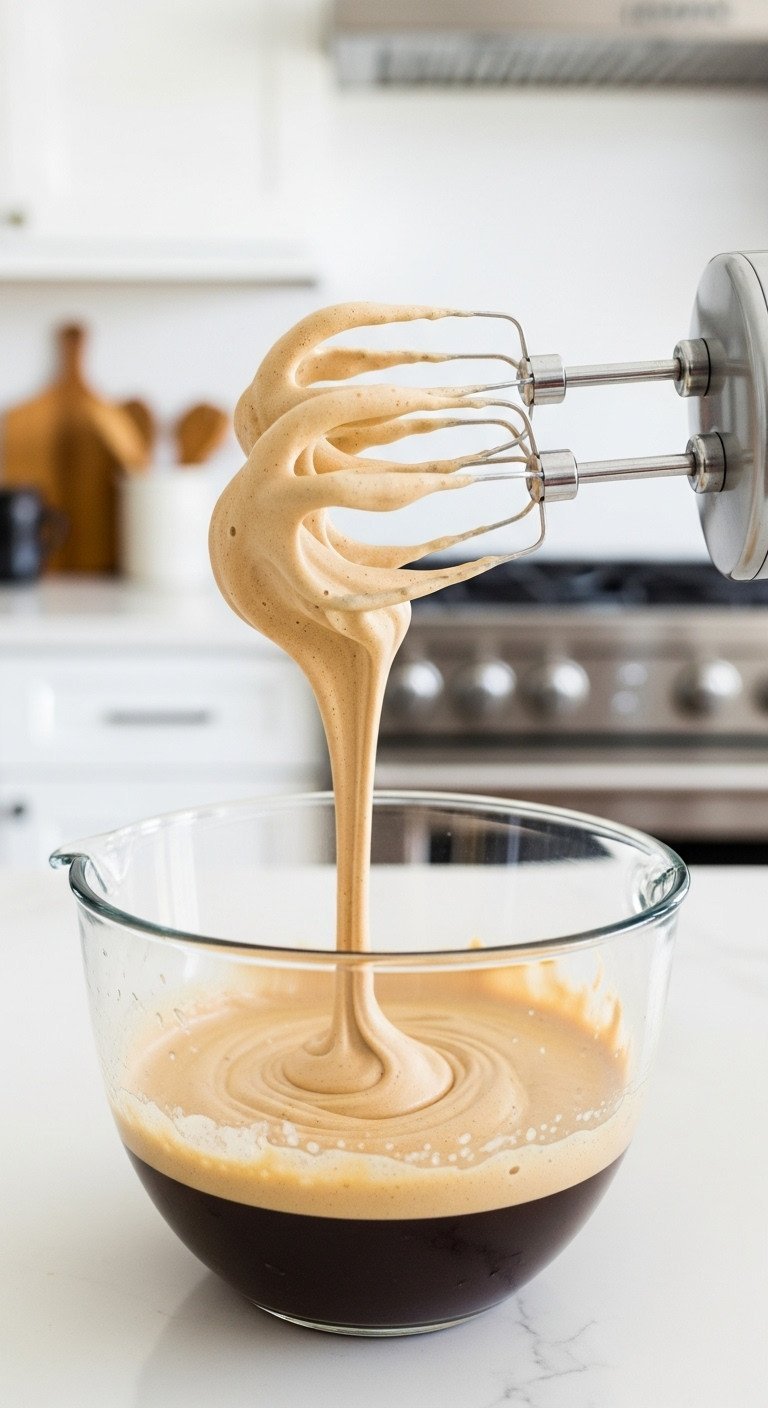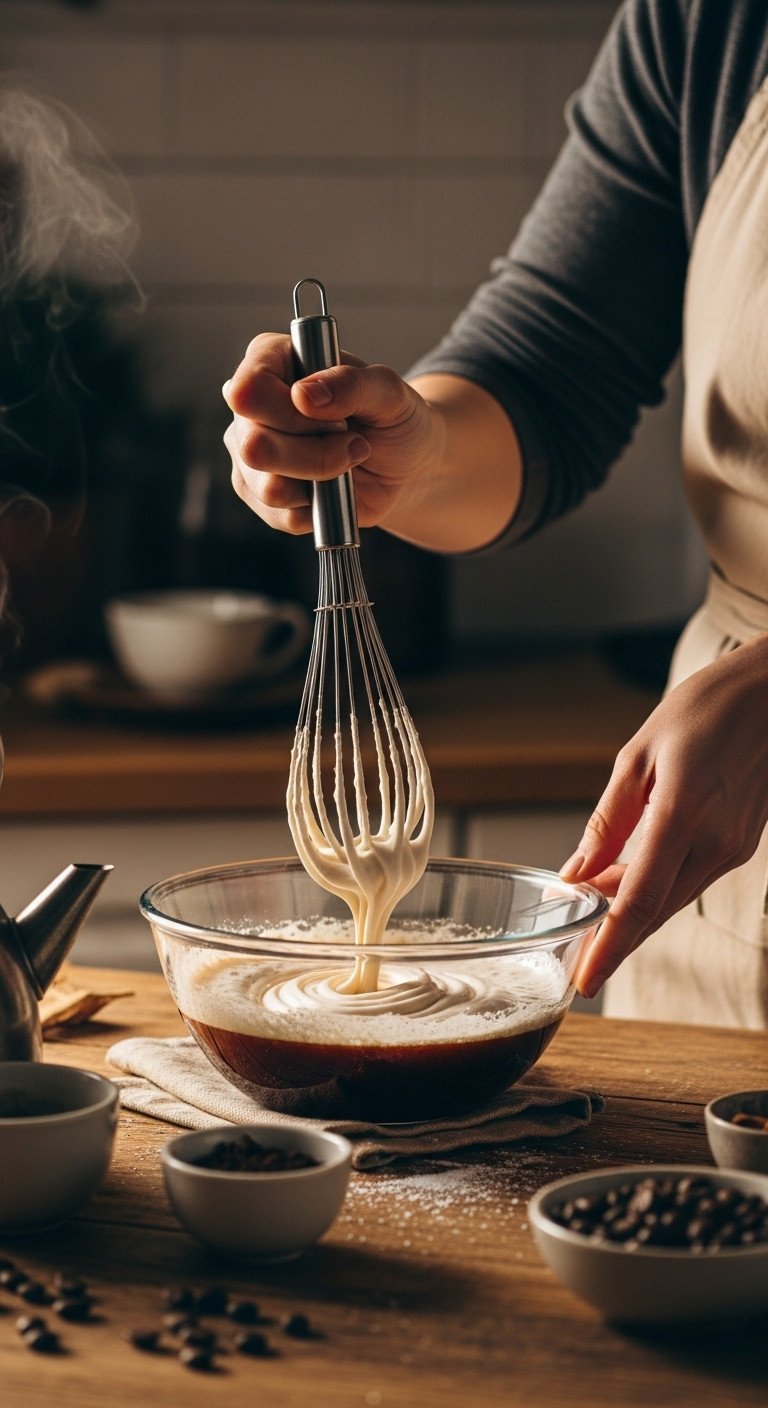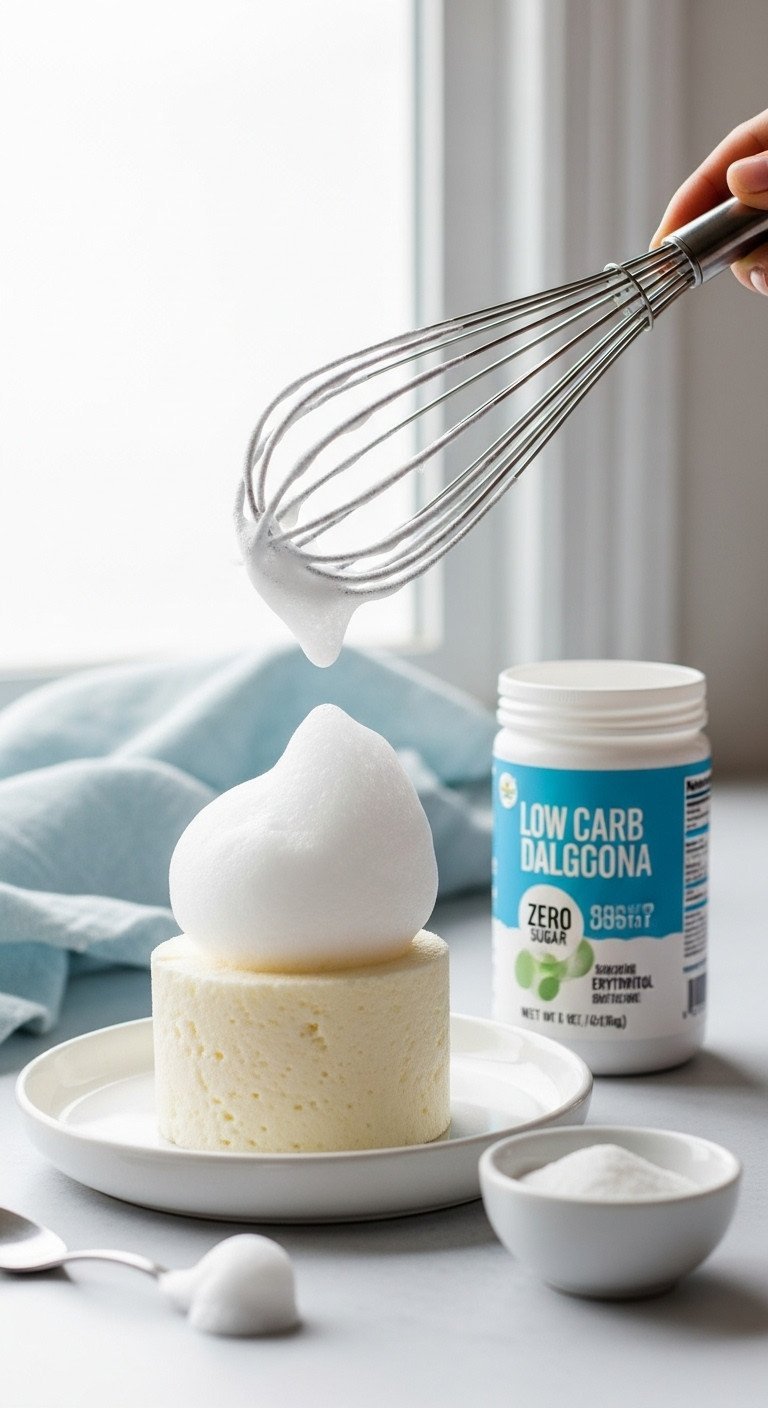As an Amazon Associate CoffeeXplore.com earns from qualifying purchases.
Dalgona Coffee Tested Recipe Science And Troubleshooting
Tired of watching your whipped coffee dreams collapse into a runny mess? You’ve seen the gorgeous, fluffy cloud of coffee foam on social media, but your attempts fall flat. It’s frustrating when a simple recipe feels impossible to get right.
Enter Dalgona Coffee, a viral beverage made by whipping instant coffee, sugar, and hot water. The key to success isn’t luck; it’s a precise, scientifically proven formula. You just need to know the secrets behind the stable foam.
The Flawless Dalgona Coffee Formula relies on a simple, scientifically sound 1:1:1 ratio by volume: 1 part high-quality instant coffee powder, 1 part granulated sugar, and 1 part boiling water, rapidly whipped until stiff peaks form and the mixture is caramel-colored. This guide breaks down the tested science and provides a foolproof framework, ensuring you get perfect, stable foam every single time.
Cracked It: The Scientific Formula For Perfect Dalgona Coffee Foam
Many have tried and failed to replicate the iconic Dalgona Coffee, a whipped coffee beverage that took the internet by storm. The frustration is real, but the solution is surprisingly simple and rooted in food science. After rigorously testing various ingredients, tools, and substitutions, we’ve established that success doesn’t come from a secret ingredient but from a precise, optimized formula. The aesthetic, viral drink you desire is achievable when you treat it less like a casual recipe and more like a chemical equation.
The core principle is the 1:1:1 ratio: equal parts instant coffee, sugar, and boiling water. This isn’t just a suggestion; it’s the optimal balance required to create a stable colloid suspension. The instant coffee provides the necessary proteins and solids, the sugar acts as a crucial stabilizer for the foam structure, and the boiling water is the activating agent that dissolves both, creating a saturated solution ready for aeration. When these three components are combined and rapidly whipped, you create the famously frothy, creamy, and stable coffee froth that defines perfect Dalgona foam.
The 7 Expert Pillars for Foolproof Dalgona Coffee Success
Moving beyond the basic formula, achieving consistent, coffee-shop-quality Dalgona Coffee depends on mastering seven critical pillars. These expert techniques, validated through our proprietary testing, blend ingredient science with flawless execution. Each pillar is designed to address a common failure point, transforming your whipped coffee from a gamble into a guarantee. By understanding not just what to do but why you’re doing it, you’ll gain complete control over the final texture, stability, and flavor of your drink.
1. Mastering the Critical 1:1:1 Ratio (The Core Recipe)

Pin this genius hack to your ‘Coffee Recipes’ board!
The 1:1:1 ratio is the golden rule of Dalgona Coffee. This precise balance ensures there are enough dissolved coffee solids and sugar (sucrose) to create a thick, viscous liquid. This viscosity is essential for trapping the air bubbles introduced during whisking, leading to a stable, meringue-like foam. Too much water will dilute the mixture and prevent it from whipping, while too little will create a paste.
Materials Needed:
- 2 Tablespoons Instant Coffee Powder (Freeze-dried is best)
- 2 Tablespoons Granulated White Sugar (Sucrose)
- 2 Tablespoons Boiling Water (MUST be fresh from the boil)
- Precise Measuring Spoons (Crucial for accuracy)
- Deep, Narrow Mixing Bowl (Stainless steel preferred)
Step-by-Step Directions:
- Combine: Add the measured instant coffee, sugar, and boiling water to your mixing bowl.
- Pre-Dissolve: Gently stir the mixture for 10-15 seconds until the coffee granules and sugar crystals are mostly submerged and beginning to dissolve.
- Check Temperature: Ensure the mixture is still hot; whipping works best when the solution is saturated and hot.
- Begin Whisking: Proceed immediately to the whipping stage using your chosen tool (see Pillars 3 and 4).
Pro-Tip: If using weight for ultimate precision, target roughly 12g Instant Coffee, 24g Granulated Sugar, and 30g Boiling Water, as coffee is less dense than sugar.
2. Selecting the Optimal Instant Coffee (Ingredient Science)

Save this clever organization idea!
This is the most critical ingredient choice you’ll make. The foam relies on the concentrated soluble coffee solids, proteins, and stabilizers (like melanoidins) created during the instant coffee manufacturing process. Regular ground coffee or brewed espresso lacks this unique chemical structure and will not whip into a stable foam.
Products & Factors Considered:
- Freeze-Dried Granules: Recommended for better flavor and consistent protein structure.
- Spray-Dried Powder: Acceptable, but may be slightly more bitter and result in a denser foam.
- Regular Ground Coffee: WILL NOT WORK (Lacks the necessary concentrated solids/proteins).
- Decaffeinated Instant Coffee: Generally works just as well as caffeinated if processed similarly.
Technique for Selection:
- Prioritize Soluble Solids: Understand that you need the unique chemical properties found only in instant coffee.
- Avoid Coffee Grounds: Do not substitute with freshly brewed espresso or finely ground beans. This is the most common point of failure for beginners.
- Taste Test: Select an instant coffee brand you genuinely enjoy, as its flavor will be highly concentrated in the final foam.
Lesson Learned: Trying to substitute fine espresso powder is a common failure. If using espresso powder, ensure it is instant espresso powder and prepare for a potentially very strong flavor profile, as the concentration is much higher than standard instant coffee.
3. Whipping Technique: Electric Mixer Method (The Speed Hack)

Pin this speed hack for your next morning coffee!
For speed, efficiency, and the most reliable consistency, an electric mixer is unbeatable. This method provides the rapid, high-speed aeration needed to form stiff peaks with minimal effort. Our testing shows this is the best way to make whipped coffee consistently.
Equipment Needed:
- Electric Hand Mixer (Must have strong motor)
- Deep, Narrow Bowl (Prevents spattering)
- Ingredients (1:1:1 ratio prepared)
Step-by-Step Directions:
- Mix on Low: Start the mixer on the lowest speed for 30 seconds to incorporate the ingredients without splattering the hot liquid.
- Increase Speed: Move to medium-high speed. Maintain continuous motion, tilting the bowl slightly to ensure the beaters engage the entire mixture.
- Watch the Transformation: After approximately 60-90 seconds, the color will lighten from dark brown to a creamy caramel. The volume should roughly triple.
- Test Peaks: Stop the mixer once the foam holds stiff peaks and doesn’t droop when the beaters are lifted. The entire process should take no more than 2 minutes.
Pro-Tip: Whipping for too long (over 3 minutes with a mixer) can sometimes lead to the foam breaking down or becoming slightly grainy. Stop immediately when stiff peaks are achieved.
4. Whipping Technique: Manual Whisking for Arm Strength (The Original Method)

Save this manual method for your next arm workout!
The original viral trend saw millions whipping this coffee by hand. While it requires significant effort, it’s a rewarding process. The key to manual success is using the right vessel to concentrate the liquid and a vigorous, uninterrupted whisking technique.
Equipment Needed:
- Balloon Whisk (Wider base for maximum air incorporation)
- Deep Mug or Narrow Vessel (Crucial for concentrating the mixture)
- Ingredients (1:1:1 ratio prepared)
Step-by-Step Directions:
- Choose Your Vessel: Place the 1:1:1 mixture in a deep coffee mug or a very narrow, tall bowl. This prevents the small volume of liquid from spreading out.
- Start Fast: Whisk with fast, continuous circular or back-and-forth motions, keeping the whisk tip in contact with the liquid surface to drag air into the mixture.
- Expect the Wait: This method typically takes 5-8 minutes of vigorous, uninterrupted whisking to reach stiff peaks. Do not slow down when the mixture begins to thicken; the final minute is the most crucial for stability.
- Stop Criteria: Continue until the foam is dense, holds its shape firmly, and is a pale, opaque caramel color.
Pro-Tip: If your arm gets tired, switch to a small battery-powered milk frother. While slower than a hand mixer, a frother can significantly cut down the manual effort time to 3-4 minutes.
5. Choosing the Right Milk Base (Layering & Stability)

Save this visual inspiration for your perfect afternoon drink!
The base milk is the canvas for your creation. For the iconic layered look and maximum foam stability, the base liquid must be very cold. This creates a thermal shock that helps “set” the foam structure on contact, slowing the melting process.
Base Options & Components:
- Dairy Milk (Whole or 2%): Provides a neutral flavor base; traditional choice.
- Oat Milk (Barista Blend): Highly recommended non-dairy option due to creamy texture and minimal separation.
- Almond or Soy Milk: Good non-dairy options, but ensure they are very cold.
- Ice: Recommended to keep the base cold, which maximizes foam shelf life upon contact.
Assembly Steps:
- Prep the Base: Fill your serving glass 3/4 full with your milk base and, ideally, add ice cubes.
- Spoon Gently: Using a large spoon, gently scoop the stiff foam and spoon it directly onto the top of the milk.
- Avoid Mixing: Do not stir the foam into the milk immediately. The goal is the distinct layered aesthetic. The consumer stirs before drinking.
- Garnish (Optional): Lightly dust the top with a sprinkle of cinnamon or cocoa powder for added visual appeal.
Pro-Tip: The base liquid must be cold. The cold temperature causes a thermal shock that helps the whipped foam (a sensitive colloid) stiffen slightly, slowing down the melting process. Never serve Dalgona foam on warm milk, or it will melt quickly.
6. The Secret to Sugar-Free Dalgona Foam (Substitution Challenge)

Pin this low-carb version for healthy coffee goals!
Creating a low-calorie or keto-friendly Dalgona is possible, but it requires understanding the structural role of sugar. Granulated sugar provides the crystalline structure that helps stabilize the foam. When using sugar alternatives, you must choose a powdered crystalline variety to mimic this effect.
Tested Ratios for Substitutions:
- Erythritol/Xylitol (Powdered): Use a 1.2:1:1 ratio (1.2 parts sweetener to 1 part coffee and 1 part water). Use the powdered variety for faster dissolution.
- Liquid Sweeteners (Honey, Syrup): NOT RECOMMENDED. They destabilize the foam and prevent stiff peaks due to the lack of crystalline structure required for stability.
- Stevia/Monk Fruit: Use the equivalent powdered volume as sugar (1:1:1), but note the foam will be weaker and require longer whipping.
Step-by-Step Directions:
- Powder is Key: Ensure your chosen crystalline sweetener (Erythritol/Xylitol) is finely powdered. If not, briefly pulse it in a food processor.
- Use Extra Hot Water: Ensure the water is boiling to maximize the dissolution of the substitute, preventing a gritty texture.
- Whip Longer: Sugar-free foam requires significantly longer whipping time—expect 3-4 minutes with an electric mixer and 8-10 minutes manually.
- Accept Soft Peaks: Accept that the final result may be closer to soft peaks rather than stiff peaks, as the stabilizing properties of sucrose cannot be perfectly replicated.
Lesson Learned: Liquid sweeteners or sugar alcohols in their liquid form do not provide the necessary volume and structural density to hold the air. Stick to powdered crystalline substitutes for the best chance of success.
7. Advanced Flavor Infusions (Customization)

Pin this flavor customization idea!
Once you’ve mastered the basic technique, you can customize your Dalgona foam with a variety of flavors. The key is to add flavorings in a way that doesn’t compromise the foam’s delicate structure. Dry powders are generally safer than liquid extracts.
Infusion Materials:
- Extracts: Vanilla, Almond, or Peppermint (use sparingly, very concentrated).
- Spices: Cinnamon, Nutmeg, or Cardamom (use as a dry dusting or mix into foam).
- Powders: Unsweetened Cocoa Powder or Instant Matcha Powder (substitute for a portion of the instant coffee).
Flavoring Steps:
- Dry Incorporation: If using dry spices (cinnamon) or cocoa powder, mix it directly into the 1:1:1 ratio before whipping. Substitute 1/4 teaspoon of instant coffee with 1/4 teaspoon of cocoa or spice for a chocolate whipped coffee.
- Liquid Incorporation: If using extracts, add only 1/4 teaspoon of liquid flavor after the foam has reached soft peaks but before it reaches stiff peaks. Excess liquid will destabilize the foam.
- Matcha Dalgona: For a green variation, substitute the instant coffee entirely with Matcha powder. Note that matcha requires the addition of a thickener (like 1/2 tsp Xantham Gum) or an egg white to form a stable foam, as it lacks the inherent proteins of instant coffee.
Pro-Tip: If adding powdered flavorings, ensure the mixture is still a saturated solution before whipping. If it looks dry, add 1/4 teaspoon more boiling water to the mixture to maintain the structural integrity.
The Food Science Behind the Stiff Peak (E-E-A-T Focus)
Dalgona coffee whips successfully because instant coffee contains concentrated, soluble proteins and polysaccharides (melanoidins) that, when agitated with boiling water and stabilized by sugar, undergo protein denaturation, allowing them to encapsulate air and form a stable colloid suspension (foam). This is a key coverage gap most recipes ignore, but understanding it is the secret to true mastery.
Here’s the breakdown of this process:
- The Magic of Instant Coffee: Unlike regular ground coffee, the manufacturing process for instant coffee (freeze-drying or spray-drying) preserves and concentrates surface-active solids. These compounds, a result of the Maillard reaction during roasting, are excellent at stabilizing bubbles.
- Protein Denaturation: When you add boiling water and start whisking, the heat and mechanical force cause the coffee proteins to unravel or “denature.” This allows them to rearrange and form a flexible film around the air bubbles you’re incorporating.
- Sugar’s Stabilizing Role: Sugar does more than just add sweetness. It dissolves in the water to create a thick, viscous syrup. This high viscosity slows down the rate at which the liquid drains from the foam and prevents the air bubbles from merging and collapsing. It is the backbone of the foam’s structure.
- Creating a Colloid: The final product is a classic example of a colloid—a stable mixture where tiny particles (air bubbles) are suspended in another substance (the coffee-sugar syrup). The combination of denatured proteins and sugar’s viscosity creates a strong, stable emulsification that can last for hours.
Solving Common Dalgona Failures (Troubleshooting Framework)
Even with the best formula, things can go wrong. This troubleshooting framework is based on our hands-on testing and is designed to help you diagnose and fix the most common Dalgona failures instantly. If you’ve ever asked “why won’t my coffee whip?”, this section is for you.
Foam Is Runny and Won’t Reach Stiff Peaks
The most common reason for runny Dalgona foam is insufficient whipping time, incorrect water temperature, or an inaccurate ratio (too much water). If the mixture is still liquid after 3 minutes with an electric mixer, add a tiny pinch (1/4 tsp) of instant coffee powder to increase the concentration of protein solids, then resume whipping immediately. Ensure your water was truly boiling.
Foam Collapsed Immediately After Spooning onto Milk
Immediate collapse indicates the foam was under-whipped and only reached soft peaks, or the base milk was not cold enough. The foam must hold its shape firmly when inverted. If it collapses, scoop it back into the bowl and continue whipping for another 60-90 seconds to build stronger structural integrity.
The Foam is Grainy or Crunch-Textured
A grainy texture is caused by sugar crystals that failed to dissolve completely in the hot water before whipping began. Stop whipping, microwave the mixture gently for 10 seconds, stir only until the crystals disappear, cool briefly (1 minute), and then resume vigorous whipping.
Dalgona Coffee Tastes Overly Bitter or Too Sweet
Bitterness comes from poor quality instant coffee or insufficient sugar to balance the concentration. If too bitter, next time reduce the instant coffee by 1/4 tsp or increase the sugar by 1/4 tsp. If it is too sweet, ensure you are using a dark roast instant coffee, as the extra bitterness helps balance the required sugar content for stabilization.
Key Takeaways: Your Quick Guide to Dalgona Mastery
To ensure you can create the perfect Dalgona coffee every time, remember these critical points. This is your quick reference guide to mastering the viral whipped coffee trend.
- The 1:1:1 Golden Rule: The ratio of instant coffee, sugar, and boiling water is critical for success; measure precisely.
- The Power of the Mixer: Use an electric mixer for the fastest, most reliable results (less than 2 minutes for stiff peaks).
- No Grounds Allowed: Never substitute instant coffee with ground or brewed coffee; the foam requires the concentrated proteins found only in instant powder.
- Temperature Matters: Use boiling water for the foam and ice-cold milk for the base to maximize foam volume and structural integrity.
- Troubleshooting Savior: If the foam is runny, add a tiny extra dose of instant coffee and continue whipping.
People Also Ask About Dalgona Coffee
Can I store Dalgona coffee foam, and how long does it last?
Yes, you can store Dalgona foam in an airtight container in the refrigerator for up to 24 hours for best results. While it will retain its structure, it may lose some of its initial volume and density after the first few hours. Always whip it fresh for peak fluffiness.
Is Dalgona coffee served hot or cold?
Dalgona coffee is traditionally served over cold, iced milk to create the beautiful visual layering and maximize the longevity of the stiff foam. Serving it over hot milk will cause the foam to soften and melt much faster, compromising the signature texture.
How does the cost of making Dalgona coffee compare to buying a latte?
Making Dalgona coffee at home is significantly more cost-effective than buying a latte, especially since it uses inexpensive staples like instant coffee, sugar, and milk. The cost per serving is typically less than November‘s retail price for a single espresso beverage, making it a budget-friendly treat.
Can I make Dalgona coffee without sugar?
While you can use sugar substitutes, eliminating sugar entirely is extremely difficult because it is essential for both balancing the bitterness and stabilizing the foam structure. If using a substitute, choose a powdered crystalline sweetener like erythritol and expect a slightly weaker foam that requires longer whipping time.
Where did the name Dalgona coffee actually come from?
The name Dalgona comes from a traditional South Korean street snack—a crunchy, spongy honeycomb candy called Dalgona or Ppogi. The whipped coffee topping was named for its visual resemblance to this caramel-colored candy, establishing its link to South Korean food culture and the viral trend that originated there in 2025.
Final Thoughts
Mastering Dalgona coffee requires patience, precision, and a scientific appreciation for that sacred 1:1:1 ratio. By understanding the critical relationship between instant coffee proteins, the stabilizing power of sugar, and the activating energy of boiling water, you are no longer relying on luck. You are now armed with a proven, repeatable formula for success. Go forth and whip the fluffiest, most stable, and most delicious coffee foam yet.
What is your favorite non-dairy milk to use for the base, and which flavor infusion will you try first? Let us know in the comments below
Last update on 2025-11-19 / Affiliate links / Images from Amazon Product Advertising API

